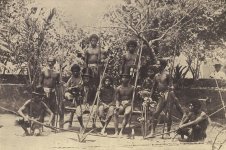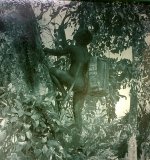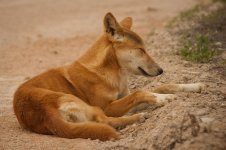Hi Folks.. first post, pls excuse me if this is already discussed to death..
But posting here because I find the idea that Aboriginals took a boat from Asia to Australia, some 50k years ago and those indigenous people in Aussie now are the results of that boat, a little bit difficult to swallow.
The boats men created 50000 years ago were probably not that great, given that we are talking about south asian hunter gatherers from the stone age. So how many of them were on a boat, I guess there must be male and females, otherwise these settlers wouldnt of lasted very long. So we have to believe that stone age man (and family) were cruising around SE Asia on boats, exploring, looking for a new land.
But its interesting to learn that apparently the Aboriginals did not come up with a an actual dug-out canoe until the 17th century, before this they were using canoes of animal skins (probably not great for transporting families around in). So did they forget how to make boats? Possible I guess..
However, what I find really puzzling are the recent revelations that some Amazonian tribes and Aboriginals share ancestry, however its not shared with northern amaerican indians.. So how did those amazon indians get there from Aussie?
Also interesting to learn taht the oldest remains of aboriginals have been found in SOUTH australia, dating back some 50k years.. Big country.. Youd expect to find bones in the North, given that they were supposed to have landed up there first..
So whats the deal?
But posting here because I find the idea that Aboriginals took a boat from Asia to Australia, some 50k years ago and those indigenous people in Aussie now are the results of that boat, a little bit difficult to swallow.
The boats men created 50000 years ago were probably not that great, given that we are talking about south asian hunter gatherers from the stone age. So how many of them were on a boat, I guess there must be male and females, otherwise these settlers wouldnt of lasted very long. So we have to believe that stone age man (and family) were cruising around SE Asia on boats, exploring, looking for a new land.
But its interesting to learn that apparently the Aboriginals did not come up with a an actual dug-out canoe until the 17th century, before this they were using canoes of animal skins (probably not great for transporting families around in). So did they forget how to make boats? Possible I guess..
However, what I find really puzzling are the recent revelations that some Amazonian tribes and Aboriginals share ancestry, however its not shared with northern amaerican indians.. So how did those amazon indians get there from Aussie?
Also interesting to learn taht the oldest remains of aboriginals have been found in SOUTH australia, dating back some 50k years.. Big country.. Youd expect to find bones in the North, given that they were supposed to have landed up there first..
So whats the deal?





